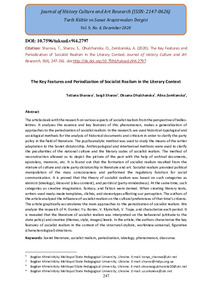Please use this identifier to cite or link to this item:
http://elar.tsatu.edu.ua/handle/123456789/15113Full metadata record
| DC Field | Value | Language |
|---|---|---|
| dc.contributor.author | Sharova, T. | - |
| dc.contributor.author | Sharov, Sergii | - |
| dc.contributor.author | Шаров, Сергій Володимирович | - |
| dc.contributor.author | Шаров, Сергей Владимирович | - |
| dc.contributor.author | Ohulchanska, O. | - |
| dc.contributor.author | Zemlianska, A. | - |
| dc.date.accessioned | 2021-08-18T10:52:55Z | - |
| dc.date.available | 2021-08-18T10:52:55Z | - |
| dc.date.issued | 2020 | - |
| dc.identifier.uri | http://elar.tsatu.edu.ua/handle/123456789/15113 | - |
| dc.description.abstract | The article deals with the research on various aspects of socialist realism from the perspective of belles-lettres. It analyzes the essence and key features of this phenomenon, makes a generalization of approaches to the periodization of socialist realism. In the research, we used historical-typological and sociological methods for the analysis of historical documents and criticism in order to clarify the party policy in the field of literature. The psychoanalytic method was used to study the means of the writer adaptation to the Soviet dictatorship. Anthropological and intertextual methods were used to clarify the peculiarities of the national culture and the literary codes of socialist realism. The method of reconstruction allowed us to depict the picture of the past with the help of archival documents, epistolary, memoirs, etc. It is found out that the formation of socialist realism resulted from the mixture of culture and state party dictatorship in literature and art. Socialist realism provided political manipulation of the mass consciousness and performed the regulatory function for social communication. It is proved that the theory of socialist realism was based on such categories as ideiinist (ideology), klasovist (class content), and partiinist (party-mindedness). At the same time, such categories as creative imagination, fantasy, and fiction were denied. When creating literary texts, writers used ready-made templates, clichés, and stereotypes affecting our perception. The authors of the article analyzed the influence of socialist realism on the cultural preferences of that time’s citizens. The article graphically accumulates the main approaches to the periodization of socialist realism. We analyze the research of H. Gunter, Yu. Boriev, V. Klymchuk, V. Tiupa, and characterize each period. It is revealed that the literature of socialist realism was interpreted on the behavioral (attitude to the state policy) and creative (themes, style, images) levels. In the article, the authors characterize the key features of socialist realism in the context of the structural-stylistic, worldview-universal, figurative (characterological) directions. | uk |
| dc.language.iso | en | uk |
| dc.relation.ispartofseries | Journal of History Culture and Art Research;Vol. 9 (4) (P. 247–261) | - |
| dc.subject | Soviet literature | uk |
| dc.subject | socialist realism | uk |
| dc.subject | periodization | uk |
| dc.subject | ideology | uk |
| dc.subject | phenomenon | uk |
| dc.subject | discourse | uk |
| dc.title | The Key Features and Periodization of Socialist Realism in the Literary Context | uk |
| dc.type | Article | uk |
| Appears in Collections: | Кафедра Комп'ютерні науки | |
Show simple item record
CORE Recommender
???jsp.display-item.check???
Items in DSpace are protected by copyright, with all rights reserved, unless otherwise indicated.

